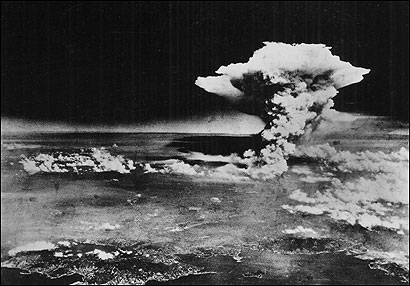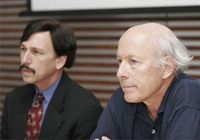 |  Remember Hiroshima! - Remember Nagasaki! | |
|
| ||
Documents emerging from once-closed Soviet archives are forcing historians to rewrite the history of the last days of World War II and reassess the impact of the Hiroshima bomb on Japan's surrender. Tsuyoshi Hasegawa, a professor of history at the University of California-Santa Barbara, said the evidence shows that it wasn't so much the bombing of Hiroshima and Nagasaki that forced the Japanese to capitulate in August 1945, but the Soviet invasion of Manchuria and impending threat of Soviet occupation of the Japanese mainland. "I think the Soviet presence was crucial," said Hasegawa, author of "Racing the Enemy: Stalin, Truman and the Surrender of Japan." Hasegawa, whose specialty is Russian history, said histories for the last half-century have treated the Soviet entry into the war against Japan on Aug. 8 as a sideshow. U.S. textbooks today emphasize the use of the atomic bomb on Hiroshima on Aug. 6 and the bombing of Nagasaki on Aug. 9 as the decisive action forcing the Japanese to surrender by Aug. 14. But Hasegawa said the bombing of Hiroshima didn't deliver a knockout punch, and the bombing of Nagasaki got surprisingly little notice at the highest levels of the Japanese government, which already was trying to find a way to end the war. "Of course it had an impact, but it was not that decisive," said Hasegawa, who studied imperial Japanese war records in Tokyo as well as Soviet archives. "What it did was to inject urgency into Japanese diplomatic efforts to end the war." Western historians first obtained once-closed Soviet archives during the period of perestroika in the 1990s, when Russian reformers made Stalin's papers available for the first time. Russian President Vladimir Putin has since closed many of the archives to Western researchers, but Russian historians recently were allowed again to see the papers. Hasegawa said he was also surprised to find that Japanese historians have done little work in Tokyo's archives exploring the activities of Emperor Hirohito in the last days of the war - a shortcoming he attributes to Japanese sensitivities about the role of the emperor in World War II. Hasegawa said many Japanese leaders wanted to end the war in July, but Hirohito's hopes of gaining a mediated settlement that would leave him in power delayed the surrender for a month. Doug Long, a retired computer programmer who runs a Web site on the Hiroshima bomb from his home in Rio Rancho, N.M., said Hasegawa's study has provided fresh insights into the last days of World War II and shows how the Soviet archives are broadening historical understanding of the chaotic days after the atomic bomb was dropped on Japan.
Long said the Soviet records are "confirmation of what we knew or surmised" and are key to filling gaps for historians trying to put together the story of how the war ended. University of Pittsburgh historian Donald Goldstein, author of several books on the war in the Pacific, agreed that the Soviet documents provide "a new slant" on Stalin's involvement that had been withheld from the public for decades. Goldstein said it's clear that Japan was fatally crippled by the summer of 1945. Japanese diplomats began trying to find a way to bring the war to an end by April, looking for a deal that would keep the country's emperor system intact. By the summer, Japanese leaders knew the allies intended to bring the Nazis to trial for war crimes and feared the same would happen to them and Hirohito. "They were trying to get the best deal, but the word came back, no deal," Goldstein said. Truman monitored the Japanese diplomatic efforts through electronic intercepts of diplomatic codes, which provided the texts of messages Japan's foreign minister, Shigenori Togo, sent to the Japanese ambassador in Moscow seeking Stalin's help in ending the war. Stalin describes in some of the Soviet documents how he "lulled the Japanese to sleep" while secretly preparing for war. By mid-1945, Truman was increasingly alarmed about Soviet occupation of Europe and concerned that Soviet involvement in Asia could result in a divided Japan. The Soviet archives confirm that Truman had some justification for these concerns and detail Stalin's maneuvering that continued the Soviet war against Japan for two weeks after Japan's Aug. 14 surrender. While denying to American diplomats that he was involved in the continued fighting, the Soviet records show that Stalin ordered the Red Army to seize Manchuria and the Japanese islands. Hasegawa said Soviet archives show that Stalin considered even invading Japan's northern island of Hokkaido. "Stalin's role was very crucial in the drama of ending the war," he said. "This was totally in the dark, we didn't know it." (Contact Lance Gay at GayL(at)SHNS.com. Distributed by Scripps Howard News Service | ||||||||||||||||||
|
New research on Hiroshima, Nagasaki Truman was a war criminal By John Catalinotto Published by Workers World, Aug 5, 2005 Why was Harry Truman's decision to use atomic weapons against Hiroshima and Nagasaki, Japan, 60 years ago, like George Bush's decision to invade Iraq in 2003? They were both war crimes, of course. And they were both based on a Big Lie. In Bush's case the lie was the now-discredited claim that the U.S. had to invade Iraq to stop the use of "weapons of mass destruction." In Truman's case, it was that the U.S. had to drop A-bombs to force the Japanese to surrender—or this would require a land invasion that would cost hundreds of thousands of U.S. casualties. With the 60th anniversary of the bombings coming up, it is more than likely that the big lie of 1945 will be repeated ad nauseam by politicians, corporate media and bought-off historians of U.S. academia. There are, however, two historians who are marshaling old and new arguments and facts to expose this lie.
Their findings support an argument made earlier: that the main reason the U.S. used nuclear weapons on Japan was to get a jump start on the war against the Soviet Union. Truman used the bomb in 1945 so the U.S. could threaten to use it against Korea, Vietnam and in many other battles. These new findings reveal that the U.S. officials making the decisions themselves knew and admitted their Big Lie was a lie. The two historians studied the diplomatic archives of the U.S., Japan and the USSR. They found that on Aug. 3, 1945, three days before Hiroshima, Truman agreed at a meeting that Japan was “looking for peace.” All the U.S. senior generals and admirals, including Gen. Dwight Eisenhower, Gen. Douglas MacArthur and Admiral William Leahy, told him it was unnecessary to use the A-bomb to defeat Japan. “Impressing Russia was more important than ending the war,” Selden says. Kuznick and Selden also show that the Japanese authorities were anxious to avoid a Soviet invasion of the Japanese main islands. The USSR officially entered the Pacific war on Aug. 9, 1945, sweeping through Japanese-occupied China and half of Korea. At the press conference, Kuznick and Selden didn’t discuss in detail why the Japanese imperialists feared a Soviet occupation more than one by the U.S., when the U.S. posture was so hostile to Japan. The Japanese imperialists’ fear can only be explained by the socialist underpinnings of the USSR, which threatened a change in property relations wherever the Red Army liberated territory. This happened, for example, in Eastern Europe and East Germany. On Aug. 15, 1945, Truman ordered a survey of the war events. Published over a year later, it stated: “Based on a detailed investigation of all the facts, and supported by the testimony of the surviving Japanese leaders involved, it is the Sur vey’s opinion that certainly prior to 31 December 1945, and in all probability prior to 1 November 1945, Japan would have surrendered even if the atomic bombs had not been dropped, even if Russia had not entered the war, and even if no invasion had been planned or contemplated.” Nov. 1 was the date the U.S. had planned the invasion. ‘A crime against humanity’ In Hiroshima, an estimated 80,000 people were killed in a split second on Aug. 6. Some 13 square kilometers of the city were obliterated. By December, at least another 70,000 people had died from radiation and injuries. Three days later, on Aug. 9, the U.S. dropped an A-bomb on Nagasaki, resulting in the deaths of at least 70,000 people before the year was out. About 10 percent of the casualties were Koreans forced to work in Japan at the time. Kuznick and Selden put most of the blame on Truman. “He knew he was begin ning the process of annihilation of the species,” says Kuznick, “It was not just a war crime; it was a crime against humanity.” A revealing comment regarding U.S. war crimes came from John Bolton, recently appointed U.S. ambassador to the United Nations. Bolton was arguing in 1998 against the International Criminal Court. “Much of the media attention to the American negotiating position on the ICC concentrated on the risks perceived by the Pentagon to American peacekeepers stationed around the world,” wrote Bolton. ... “[O]ur real concern should be for the president and his top advisers.” Bolton continued: “The definition of ‘war crimes’ includes, for example: ‘intentionally directing attacks against the civilian population as such or against individual civilians not taking direct part in hostilities.’” Bolton wrote that under the ICC rules, U.S. leaders could have been found guilty of a war crime for dropping atomic bombs on Hiroshima and Nagasaki, and for all the aerial bombardments of German and Japanese civilian areas. The A-bombs were not the only crimes. U.S. nighttime raids using conventional bombs against residential areas of Tokyo, Osaka and other industrial cities caused hundreds of thousands of Japanese civilian deaths, and Dresden, Germany, was obliterated in early 1945, killing mainly refugees. But Truman’s decision opened the door to massive use of these new terror bombs. Now the Bush administration, fresh from being caught in a series of lies justifying aggression against Iraq, plans to increase the Pentagon’s reliance on a new generation of nuclear weapons. On the 60th anniversary of Hiroshima, it is past time to organize to prevent the new crimes U.S. imperialism has in its plans. This article is copyright under a Creative Commons License. Workers World, 55 W. 17 St., NY, NY 10011 Email: ww@workers.org |
Biographies. Documents. Glossary. Nuclear Data. Nuclear Test Sites. Timeline. References. Arms Control Treaties. Photographs. Videos. Maps. Horus Gets In Gear. Beginner's Guide to Research in the History of Science. Master Contents | Horus Publications Julius Robert Oppenheimer (1904-1967). b. April 22, 1904, New York City d. Feb. 18, 1967, Princeton, N.J., U.S. U.S. theoretical physicist and science administrator, noted as director of the Los Alamos laboratory. by Jennifer Isenbeck (Abstract). High Energy Weapons Archive on the Splitting of the Atom Really Cost Pearl Harbor Attack "Anno Atomi" details the Nuclear Testing during 1957 at the Nevada Test Site. A Portland, Oregon resident & atomic veteran, Bires' web site tells about his duties at the Nevada Test Site (NTS) during the Buster-Jangle series of atomic tests in 1951.  Remember Hiroshima Japan USA Live Project Citizens of the Earth Campaign (Painting and Poem) | |||||||||||||||||
|
See also: (Bibliography) Sun Tzu Organization claims "the Japanese were working on their own atomic bombs when Hiroshima and Nagasaki were attacked. They even exploded a test bomb in a Korean harbor." Sun Tzu also says that Sony founder Akio Morita "knew what hit Hiroshima and Nagasaki. From his autobiography, Made in Japan, Morita's knowledge of the type of weapons dropped on Hiroshima and Nagasaki is demonstrated in direct quotes from Morita in his book." Further evidence came from A Nazi submarine (Unterseeboot U-234) "captured en route to Japan with a cargo of uranium oxide, key ingredient for atomic bombs." |
the A-Bomb Chronology World War II Tribute of Memory
|


